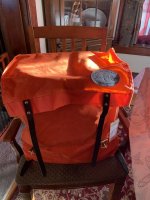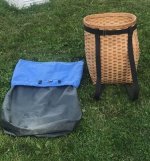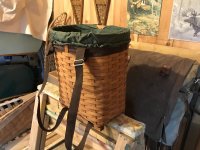I have had two pack baskets made with splints pounded out of a straight grained log and woven by a craft persons. The first I used pretty hard, never treated with anything. In time some of the splints started to break in the bottom corners. One spring I heard of a Anishinaabe grandmother on the White Earth Reservation in Minnesota that made ash baskets (not pack baskets) maybe she had some splints I could get to repair my basket. She was happy to see me, invited me in for tea, She didn't have any splints, but would show me how to make them. She had me drive her to a nearby woods, then a walked into it to a black ash swamp to a perfect tree that she knew about. I cut it down and sawed it again just below the first limbs, making it into a ten foot log, then packed it out to my truck. Back at her home we put them in a little creek to soak for a week. The next week-end she taught me to how to pound it to make splints dress them with a knife. That was a lot of work, but I ended up with a handful of splints for my use, She ended up with all the rest. The next winter I moved to Alaska, I left a bunch of my stuff including the pack basket with a school teacher girlfriend in Manhomen, MN, I never saw her or my stuff again, I later heard she had married a Minnesota State Highway Patrolman, thought it was best to let them keep my old canoe camping stuff.
My current pack basket was made in Maine, living in a dry climate I painted it many times with the pine tar "soup". I put in a Frost River Old Number 7 pack when I made my annual autumn visit to Minnesota, the combination made a nice travel bag. Once I was there I would pull the pack off the basket, then I would have two packs for my canoe fishing/camping trips, using stuff I keep stashed in Minnesota at my bachelor friend Jeff's place (no wife to complain about my stuff taking up room behind the couch). The basket has stood up to air travel which is maybe harder on it than canoe travel.
Back in the wooden cross country ski days pine tar was used to coat/melt into the bottoms of ski's to give the ski wax something to get a smooth surface to grip for glide and kick sections, another of the dark arts, like forge tempering knife blades.
yellowcanoe........
For years I used Grandpa's Pine Tar Soap, I haven't seen it anywhere I have been in the last ten years or so, not going to pay shipping fee's to Alaska for a bar of soap, so have been without it for awhile, my bride doesn't miss the smell of it. So, that is also in the equation, kinda like Lapsang Souchong Tea. Which a friend say's "it smells like Lipton brewed over a campfire."
I still use Neutrogea T/Gel shampoo, because of the pine tar smell.
I had a old Aviation Law Professor friend that lost his sense of smell because of age or misfortune. The only thing he could smell was pine tar, he would open his can of it and stick his nose almost into the tar to take a deep whiff, he could just get a hint of the smell, but it made him very happy.
.........BB








